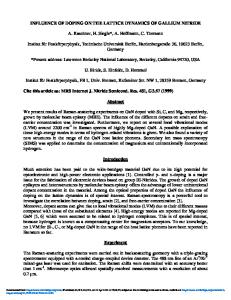Influence of doping on the electrochemical properties of anatase
- PDF / 94,622 Bytes
- 6 Pages / 595 x 842 pts (A4) Page_size
- 108 Downloads / 390 Views
EE1.3.1
Influence of doping on the electrochemical properties of anatase Marina V. Koudriachova and Simon W. de Leeuw Computational Physics, Dept. of Multiscale Physics, Delft University of Technology, Lorentzweg 1, 2628 CJ Delft, the Netherlands The effect of substitution on the intercalation properties of anatase-structured titania has been investigated in first principles calculations. Ti4+-ions were substituted by Zr4+, Al3+ and Sc3+ respectively and O2- -ions by N3-. For each compound the open circuit voltage profile (OCV) was calculated and compared to anatase. Lithium intercalation proceeds as in pure anatase through a phase separation into a Li-rich and a Li-poor phase in all cases examined here. The Li-content of the phases depends on the nature of the dopant and its concentration. Substitution by N3--ions does not lead to lower potentials, whereas doping with trivalent Sc3+- and Al3+- ions decreases the intercalation voltage. Substitution by tetravalent Zr4+-ions within the range of solubility does not significantly affect the OCV of anatase. A correlation is observed between the predicted equilibrium voltage and the participation of the Ti4+-ions in accommodating the donated electron density upon lithiation. I.
Introduction Anatase-structured titania TiO2 is a technologically important material. It has applications in solar cells, electrochromic displays and hydrogen sensors1-5). The low potential for Li-insertion (1.8 eV Li+/Li) and the remarkable stability of the electrochemical performance upon lithiation make anatase a promising candidate as anode material. For this application a lower intercalation potential is desirable. A promising way to influence the properties of electrode materials is doping with heteroatoms. A considerable amount of research has been carried out to improve electrochemical properties of a number of important cathode materials. It has been shown that suitable doping allows an increase of the equilibrium voltage, suppresses undesirable structural effects and improves the kinetics of Li-insertion/extraction6-10). In the traditional viewpoint the redox potential of the transition-metal (TM) ion, which changes valence upon Li-insertion, determines the intercalation voltage. Substitution by another TM-ion adds new features to the open circuit voltage (OCV), which correspond to a reduction of the guest TM ion6). The oxidation state of a TM ion in the solid is strongly influenced by structural factors. If the substitution stabilizes the host structure upon charge/discharge a higher intercalation voltage is observed11). Recently a different viewpoint on the reduction reaction has been put forward. Consideration of charge densities obtained from ab initio calculations has led to the suggestion that the potential for Li intercalation in late transition metal oxides is mainly determined by the participation of O-ions in electron exchange12,13). If this is the case substitution of TM-framework ions by electrochemically non-active elements with a fixed valence (sp-elements) will force elec
Data Loading...











